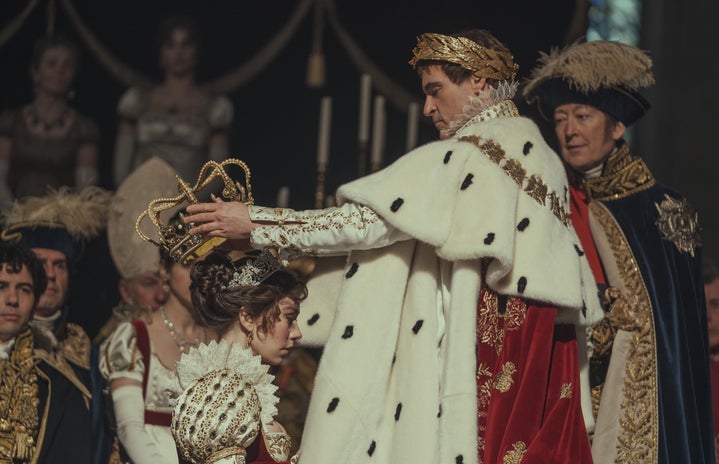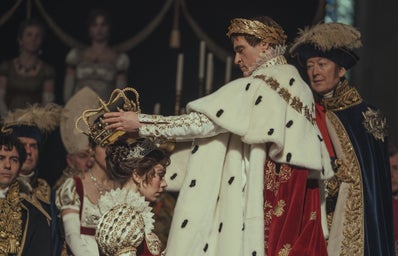Warning: This review contains spoilers for the movie “Napoleon” (2023)
Remaining true to the titular figure’s reputation, Ridley Scott’s latest historical epic “Napoleon” has attained a controversial reception from audiences. Is it a derisive hit-piece on one of history’s most misunderstood geniuses? A lifeless retelling that is woefully uninformed? Or is it a masterpiece in disguise? In hindsight, it should act as no surprise that “Napoleon” has become one of the most decisive films of the year. Historians today still debate whether Napoleon himself was a violent, tyrannical brute or an enlightened despot. The fact remains that he is one of history’s most formidable, inflammatory figures, and “Napoleon” is no different in its stature.
One scene from “Napoleon” that lingers in my mind takes place in Egypt. Utilizing a stool, Napoleon (Joaquin Phoenix) levels himself eye-to-eye with an unearthed mummy. The remains glare back at him, acting as a mirror to Napoleon’s inevitable demise. What is the ultimate fate of such imposing, eminent figures in history? What deviates illustrious emperors from common soldiers on the battlefield? As Napoleon reaches out to touch the corpse, a part of it crumbles. It echoes an age-old sentiment, “For you are dust, and to dust you shall return.”
“Napoleon” is fixated on legacy. His coronation is an ornate spectacle that suffocates the audience with opulent pearls and lustrous crowns. Napoleon’s prowess is on full display, and yet the most important object in that scene is a mere canvas. Scott focuses the camera on a singular painter known as Jacques-Louis David who sketches the accession onto his easel. In centuries to come, this monumental event would be remembered solely through the eyes of that very artist and his iconic painting “The Coronation of Napoleon” (1807). In a letter to his wife Josephine (Vanessa Kirby), Napoleon declares, “But I follow in the footsteps of Alexander the Great and Caesar.” He severs himself from his one true love because she cannot produce an heir. The first question Napoleon asks his new bride is: “Do I resemble my portrait?” Legacy, legacy, legacy – its imposing presence looms over just about every scene. How will history remember Napoleon? From Scott’s perspective, he’s certainly no hero. Upon meeting Napoleon, Josephine asks, “What is this costume you have on?” He responds nervously, “This is my uniform.” The film presents Napoleon as an infant wearing clothes twice his size, perpetually stuck with an ill-fitting “costume” that he can never quite fill.
In an interview with Letterboxd, director Ridley Scott stated that he didn’t intend to make a “history lesson,” and decided instead to center the film around Napoleon’s “obsession” with Josephine. “Napoleon” casts Josephine as a Lady Macbeth-type. Though she always remains in his shadow, the power that Josephine holds over Napoleon and his decisions runs deep. “You’re just a tiny little brute that is nothing without me,” she murmurs at one point. The line between Napoleon’s ambitious military conquests and his desire for Josephine is blurred heavily. Even when she passes, Josephine continues to haunt the narrative. In the film’s final moments before Napoleon’s death, we hear the voice of his late wife: “Come to me, Napoleon, and let’s try this again.” In the most bizarre, twisted way possible, “Napoleon” is indeed a love story.
Many of the critiques towards “Napoleon” whittle down to an overall lack of historical accuracy, as there are various parts of the emperor’s life that are misrepresented throughout the film. For me, however, what was most bothersome about “Napoleon” is its glaring emptiness. The film quickly transports us from Austerlitz to Waterloo, leaving little development between these pivotal historical moments. As a result, the narrative feels disjointed. The audience is given no reason to care about the events unfolding before them. Ridley Scott revealed, however, that “Napoleon” has a four-and-a-half hour director’s cut. It’s likely that this additional time will be utilized to patch up the abruptness of certain scenes. I am curious to see Scott’s full, unabridged vision for “Napoleon.”
The cinematography of “Napoleon” mimics the emperor’s colossal prominence in history. The film operates on such a large, breathtaking scale. Every single frame feels noteworthy and captivating. There wasn’t a single second of “Napoleon” where I felt bored. One of the most exciting sequences in the movie is the Battle of Austerlitz. Scott successfully immerses the audience into the violent, merciless atmosphere of war. The shot of the Russian soldiers drowning in unforgiving, icy waters with blood surrounding them is etched into my mind. I highly recommend seeing this film in theaters to experience firsthand just how utterly mesmerizing certain scenes are on the big screen.
Napoleon’s exile to St. Helena marks the end of his reign. The once-glorious emperor who helped lead the French army to countless victories is stuck fishing dead flies out of his wine. It mirrors the poem “Ozymandias” by Percy Bysshe Shelley: “And on the pedestal, these words appear: / My name is Ozymandias, King of Kings; / Look on my Works, ye Mighty, and despair! / Nothing beside remains. Round the decay / Of that colossal Wreck, boundless and bare / The lone and level sands stretch far away.”


